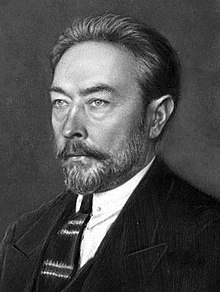Sergey Lebedev (chemist)
Sergei Lebedev | |
|---|---|
Сергей Лебедев | |
 Lebedev in 1920 | |
| Born | 13 July 1874[1][2] |
| Died | 2 May 1934 (aged 59)[1][2] |
| Resting place | Tikhvin Cemetery, Saint Petersburg |
| Nationality | Russian |
| Alma mater | St. Petersburg University |
| Spouse | |
| Scientific career | |
| Institutions | Saint Petersburg Academy for Military Medicine |
| Doctoral advisor | Alexey Favorsky |
Sergei Vasilievich Lebedev (Russian: Сергей Васильевич Лебедев; 13 July 1874 – 2 May 1934) was a Russian/Soviet chemist and the inventor of polybutadiene synthetic rubber, the first commercially viable and mass-produced type of synthetic rubber.[1]
Biography
[edit]Lebedev was born in 1874 in Lublin and went to school in Warsaw. In 1900, he graduated from St. Petersburg University and found work at the Petersburg Margarine Factory.
Starting in 1902, Lebedev moved from university to university in Russia, starting at the Saint-Petersburg Institute for Railroad Engineering. In 1904, he returned to St. Petersburg University to work under Alexey Favorsky (Stalin Prize, 1941, for contributions to the manufacture of synthetic rubber).
In 1905, he married his second wife, the artist Anna Ostroumova-Lebedeva.[3]
In 1915, Lebedev was appointed Professor at the Women's Pedagogical Institute in St. Petersburg. After 1916, he was a Professor of the Saint Petersburg Academy for Military Medicine. In 1925, he became the leader of the Oil Laboratory (after 1928, the Laboratory of Synthetic Resins) at St. Petersburg University.
He died in Leningrad and is interred in Tikhvin Cemetery.
Works
[edit]Lebedev's main works are devoted to polymerisation of diene hydrocarbons. He was the first to research the polymerisation of butadiene (1910–1913). In 1910, Lebedev was the first to get synthetic rubber based on polybutadiene. His book Research in polymerisation of by-ethylene hydrocarbons (1913) became the bible for studies of synthetic rubber.[2]
After 1914, he studied polymerisation of ethylene monomers, leading to modern industrial methods for manufacturing of butyl synthetic rubber and poly-isobutylene. Between 1926 and 1928, he developed a single-stage method for manufacturing butadiene out of ethanol. In 1928, he developed an industrial method for producing synthetic rubber based on polymerisation of butadiene using metallic sodium as a catalyst. This method became the base for the Soviet industry of synthetic rubber.[2] The Soviets lacked reliable access to natural rubber, making the manufacture of synthetic rubber important. The first three synthetic rubber plants were launched in 1932–33. For butadiene production they used grain or potato ethanol as a feedstock.[4] It caused a number of jokes about "Russian method of making tires from potatoes".
By 1940, the Soviet Union had the largest synthetic rubber industry in the world, producing more than 50,000 tons per year. During World War II, Lebedev's process of obtaining butadiene from ethyl alcohol was also used by the German rubber industry.[4]
Another important contribution of Lebedev's was the study of the kinetics of hydrogenation of ethylene hydrocarbons and the development of a number of synthetic motor oils for aircraft engines.
Honors
[edit]- In 1931, Lebedev was awarded the Order of Lenin for his work on synthetic rubber[2]
- In 1932, he became a full member of the Soviet Academy of Sciences.[1]
- In 1945 the National Institute for Synthetic Rubber[5] was named "Lebedev's Institute".[2]
References
[edit]- ^ a b c d e f "Sergey Vasilyevich Lebedev | Russian chemist | Britannica". www.britannica.com. Retrieved 8 September 2022.
- ^ a b c d e f g h "Лебедев Сергей Васильевич / Большая советская энциклопедия". gatchina3000.ru. Retrieved 8 September 2022.
- ^ "Остроумова-Лебедева Анна Петровна (1871–1955)" (in Russian). История графики. Retrieved 6 March 2015.
- ^ a b "rubber - The rise of synthetic rubber | Britannica". www.britannica.com. Retrieved 8 September 2022.
- ^ "Vniisk.ru порно видео для народа онлайн". vniisk.ru. Retrieved 8 September 2022.
External links
[edit] Media related to Sergei Vasiljevich Lebedev at Wikimedia Commons
Media related to Sergei Vasiljevich Lebedev at Wikimedia Commons- July 25 – Today In Science History at www.todayinsci.com
- Butadiene: Definition and Much More from Answers.com at www.answers.com
- 1874 births
- 1934 deaths
- Scientists from Lublin
- Soviet chemists
- Polymer scientists and engineers
- Saint Petersburg State University alumni
- Full Members of the USSR Academy of Sciences
- Academic staff of Saint Petersburg State University
- Burials at Tikhvin Cemetery
- Soviet inventors
- Chemists from the Russian Empire
